Potamogeton gramineus (Grass-leaved Pondweed)
| Also known as: | Variableleaf Pondweed |
|---|---|
| Genus: | Potamogeton |
| Family: | Potamogetonaceae (Pondweed) |
| Life cycle: | perennial |
| Origin: | native |
| Habitat: | part shade, sun; shallow to 10 feet deep soft water; lakes, ponds, streams, rivers |
| Bloom season: | July - September |
| Plant height: | 4 to 60 inches |
| Wetland Indicator Status: | GP: OBL MW: OBL NCNE: OBL |
| MN county distribution (click map to enlarge): |  |
| National distribution (click map to enlarge): |  |
Pick an image for a larger view. See the glossary for icon descriptions.
Detailed Information
Flower: 


![[photo of flowers]](/udata/r9ndp23q/pd3/potamogeton-gramineus-072417-10-t.jpg) Dense cylindrical spike held above the surface of the water, up to about 1 inch (3 cm) long at the tip of the stem and arising from upper leaf axils. Spikes have 5 to 10 whorls of flowers, each flower with a 4-parted style surrounded by 4 stamens, each stamen with a green to yellowish, ladle-shaped, sepal-like appendage.
Dense cylindrical spike held above the surface of the water, up to about 1 inch (3 cm) long at the tip of the stem and arising from upper leaf axils. Spikes have 5 to 10 whorls of flowers, each flower with a 4-parted style surrounded by 4 stamens, each stamen with a green to yellowish, ladle-shaped, sepal-like appendage.
Leaves and stems: 

![[photo of floating leaves]](/udata/r9ndp23q/pd3/potamogeton-gramineus-072617-12-t.jpg) Both submersed and floating leaves are produced, though floating leaves may be absent. Floating leaves are dark green to yellowish, elliptic to egg-shaped, about 1½ inches long, up to ¾ inch (2cm) wide, toothless, rounded or pointed at the tip, rounded at the base, on a stalk usually a little longer than the blade. Blades have 11 to 19 veins.
Both submersed and floating leaves are produced, though floating leaves may be absent. Floating leaves are dark green to yellowish, elliptic to egg-shaped, about 1½ inches long, up to ¾ inch (2cm) wide, toothless, rounded or pointed at the tip, rounded at the base, on a stalk usually a little longer than the blade. Blades have 11 to 19 veins.
![[photo of submersed leaves]](/udata/r9ndp23q/pd3/potamogeton-gramineus-072417-2-t.jpg) Submersed leaves are green to brownish, narrowly elliptic, 1 to 3½ inches long, 1/8 to 1 inch (3 to 27 mm) wide, pointed at the tip, usually stalkless, rarely on a stalk up to 1 inch long. The midvein is flanked by 1 or 2 rows of large, empty cells (known as the lacunar band) and 3 to 7 prominent lateral veins. Leaves are spirally arranged, are sometimes large, more or less flat and single at the nodes, sometimes smaller, more wavy and clustered on short lateral branches, sometimes both on the same plant.
Submersed leaves are green to brownish, narrowly elliptic, 1 to 3½ inches long, 1/8 to 1 inch (3 to 27 mm) wide, pointed at the tip, usually stalkless, rarely on a stalk up to 1 inch long. The midvein is flanked by 1 or 2 rows of large, empty cells (known as the lacunar band) and 3 to 7 prominent lateral veins. Leaves are spirally arranged, are sometimes large, more or less flat and single at the nodes, sometimes smaller, more wavy and clustered on short lateral branches, sometimes both on the same plant.
![[photo of stipule]](/udata/r9ndp23q/pd3/potamogeton-gramineus-062818-14-t.jpg) At the base of the leaf is a membranous appendage (stipule), not connected to the leaf blade, pale green to brown, up to about 1 inch long, the tip somewhat rounded and not shredding. Stems are branched and round in cross-section. Loose to dense colonies are often formed from long rhizomes. Vegetative buds (turions) are not produced. Glands at the leaf nodes are absent.
At the base of the leaf is a membranous appendage (stipule), not connected to the leaf blade, pale green to brown, up to about 1 inch long, the tip somewhat rounded and not shredding. Stems are branched and round in cross-section. Loose to dense colonies are often formed from long rhizomes. Vegetative buds (turions) are not produced. Glands at the leaf nodes are absent.
Fruit: 
![[photo of fruiting spike]](/udata/r9ndp23q/pd3/potamogeton-gramineus-081016-s2-t.jpg) Fruit is a dry seed (achene), the flowering spikes forming loosely to densely packed seed heads, greenish-brown when mature.
Fruit is a dry seed (achene), the flowering spikes forming loosely to densely packed seed heads, greenish-brown when mature.
![[photo of achenes]](/udata/r9ndp23q/pd3/potamogeton-gramineus-082119-s1-t.jpg) Achenes are irregularly oval, 1.7 to 2.7 mm long, with a low, smooth keel along the back edge and flanked by a pair of more obscure lateral keels (more distinct when dry). The surface is shallowly pitted and the beak is minute and erect.
Achenes are irregularly oval, 1.7 to 2.7 mm long, with a low, smooth keel along the back edge and flanked by a pair of more obscure lateral keels (more distinct when dry). The surface is shallowly pitted and the beak is minute and erect.
Notes:
Grass-leaved Pondweed is a common species in northern and central Minnesota, usually in the quiet waters of clear lake and pond margins with sandy or mucky substrates, often in less than 3 feet of water. The leaves are quite variable. Floating leaves are usually few in number, almost always rounded at the base, can be pointed or rounded at the tip, and the stalk is usually a little longer than the blade, sometimes a little shorter. Submersed leaves are green to brownish, narrowly elliptic, pointed at the tip, 3 to 7-veined and usually stalkless, but the size and arrangement is more variable, sometimes small leaves clustered on short lateral branches, sometimes larger leaves single at the nodes. Larger leaves are mostly flat where smaller leaves tend to be more crinkly/wavy. Stipules are not connected to the leaf and not shredding. Short plants can take on a bushy appearance and vegetative colonies are common.
Floating leaves resemble those of some other Pondweeds, but their blades may be heart-shaped or more consistently tapered at the base, leaf stalks may be consistently much longer than the blade; submersed leaves may be stalked or clasping, more ribbon-like or more broadly lance-elliptic, and/or have more than 7 veins.
Native Plant Nurseries, Restoration and Landscaping Services ↓
More photos
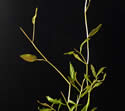 Potamogeton gramineus plant
Potamogeton gramineus plant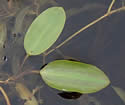 Potamogeton gramineus plant
Potamogeton gramineus plant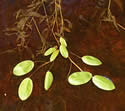 Potamogeton gramineus with Brasenia schreberi (watershield)
Potamogeton gramineus with Brasenia schreberi (watershield)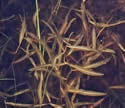 a dense patch of Potamogeton gramineus
a dense patch of Potamogeton gramineus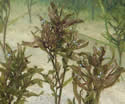 an underwater forest
an underwater forest submersed leaf veins and tip
submersed leaf veins and tip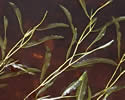 submersed leaves can be single, larger, more or less flat
submersed leaves can be single, larger, more or less flat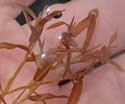 submersed leaves can be smaller, more wavy, clustered on short branches
submersed leaves can be smaller, more wavy, clustered on short branches
Photos by K. Chayka taken in Anoka and Carlton counties. Photos by Peter M. Dziuk taken in Aitkin, Anoka, Cook, Itasca and Lake counties.
Comments
Have you seen this plant in Minnesota, or have any other comments about it?






